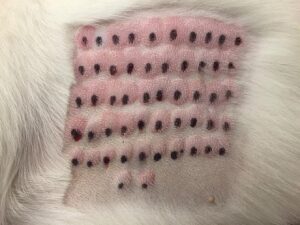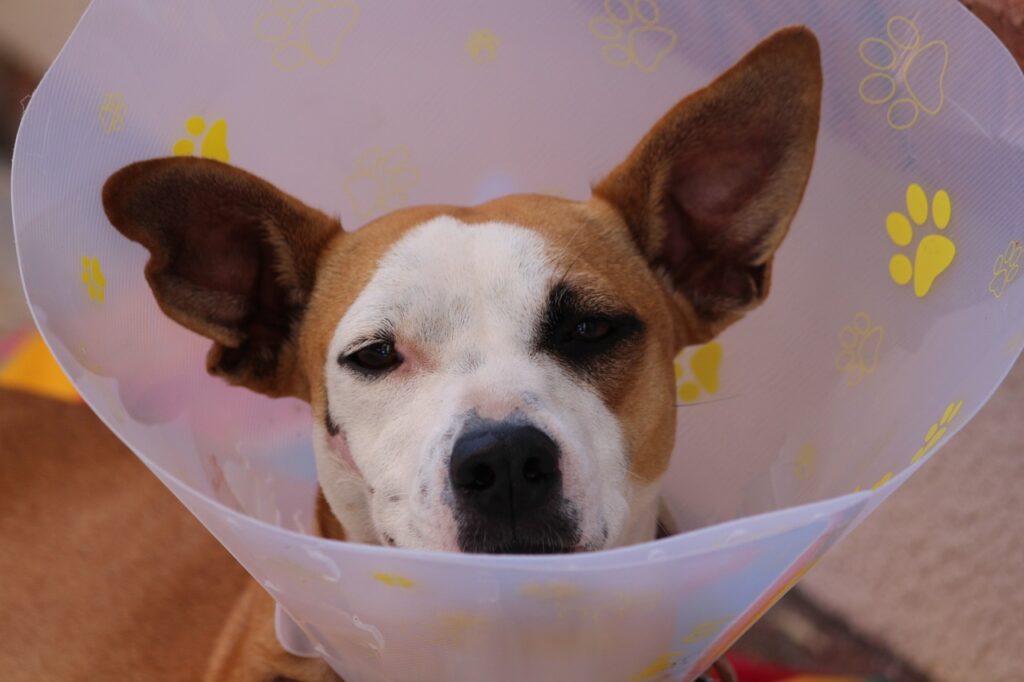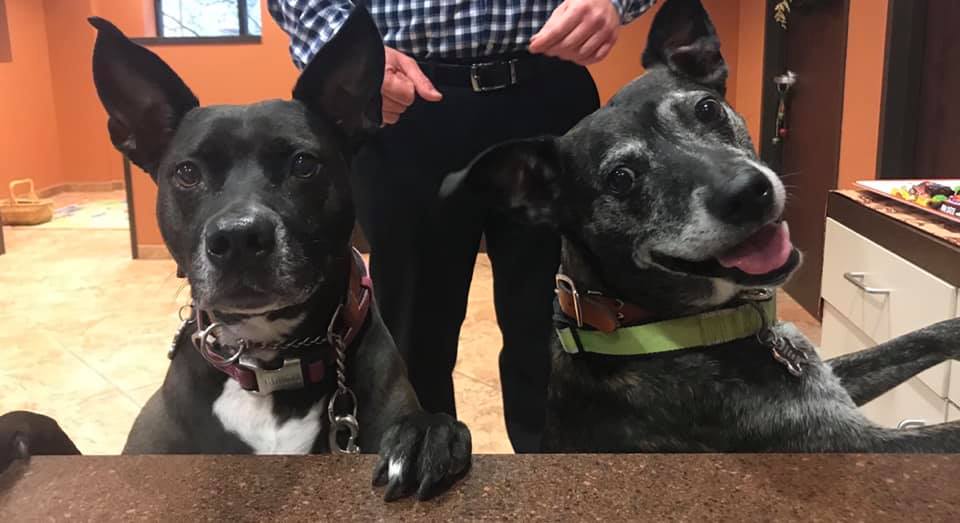Services
We are passionate about the care that we provide your pet.
Allergies are one of the most common conditions affecting the skin and ears of dogs and cats. There are different options for addressing allergies such as Allergy Testing, Food Allergy Diet Trial, and Symptomatic Therapy.
Dr. Osborn talks about Allergies on Positively Houston
Also known as Intradermal skin testing, allergy testing is the most reliable method of diagnosing environmental allergies.
Allergy testing requires only a mild sedative that makes your pet sleepy. It does not involve general anesthesia. A patch of hair is shaved over the rib cage and 55 of the most common allergens to this area are injected into the skin. The site is then evaluated for immediate and delayed reactions.

To determine the appropriate treatment plan for your pet, it is important to determine what type of infection (bacteria and/or yeast) is present. The most reliable method of determining the type of ear infection is by obtaining an ear cytology.
Ear cytology involves obtaining a sample of the ear debris with the use of a cotton tip applicator and evaluating it under a microscope. The type of bacteria or yeast present determines which topical medication will be most effective against the ear infection.
The most reliable method of determining the type of skin infection is by obtaining a skin cytology for bacteria and/or yeast, a dermatophyte culture for fungal infections, or skin scrapings for mites.
For abnormal growths, skin conditions, and auto immune diseases, a biopsy may be needed to either make or confirm a diagnosis. Samples are sent to a dermatopathologist (board certified pathologist specializing in diagnosing skin diseases).

We are passionate about the care that we provide your pet.
Allergies are one of the most common conditions affecting the skin and ears of dogs and cats. There are different options for addressing allergies such as Allergy Testing, Food Allergy Diet Trial, and Symptomatic Therapy.
Dr. Osborn talks about Allergies on Positively Houston
Also known as Intradermal skin testing, allergy testing is the most reliable method of diagnosing environmental allergies.
Allergy testing requires only a mild sedative that makes your pet sleepy. It does not involve general anesthesia. A patch of hair is shaved over the rib cage and 55 of the most common allergens to this area are injected into the skin. The site is then evaluated for immediate and delayed reactions.

To determine the appropriate treatment plan for your pet, it is important to determine what type of infection (bacteria and/or yeast) is present. The most reliable method of determining the type of ear infection is by obtaining an ear cytology.
Ear cytology involves obtaining a sample of the ear debris with the use of a cotton tip applicator and evaluating it under a microscope. The type of bacteria or yeast present determines which topical medication will be most effective against the ear infection.
The most reliable method of determining the type of skin infection is by obtaining a skin cytology for bacteria and/or yeast, a dermatophyte culture for fungal infections, or skin scrapings for mites.
For abnormal growths, skin conditions, and auto immune diseases, a biopsy may be needed to either make or confirm a diagnosis. Samples are sent to a dermatopathologist (board certified pathologist specializing in diagnosing skin diseases).


Food allergy is a common allergy among dogs and cats and can manifest itself in different ways. Unlike environmental allergies, there is no reliable skin or blood allergy test to determine what dietary allergen(s) your pet is allergic to. The most effective approach is to place your pet on a hypoallergenic diet trial involving unusual and/or hydrolyzed ingredients. The diet trial will involve ingredients that your pet has never consumed before. Potential foods include rabbit, venison, duck, etc. Should your pet be diagnosed with a food allergy, SWVD will thoroughly educate you on what’s involved in a diet trial.

Food allergy is a common allergy among dogs and cats and can manifest itself in different ways. Unlike environmental allergies, there is no reliable skin or blood allergy test to determine what dietary allergen(s) your pet is allergic to. The most effective approach is to place your pet on a hypoallergenic diet trial involving unusual and/or hydrolyzed ingredients. The diet trial will involve ingredients that your pet has never consumed before. Potential foods include rabbit, venison, duck, etc. Should your pet be diagnosed with a food allergy, SWVD will thoroughly educate you on what’s involved in a diet trial.


For many patients, chronic ear infections have been a life-long battle. Chronic ear infections can result in a middle ear infection which is an infection behind the ear drum. In order to treat this infection, we perform an anesthetic ear procedure. This is a procedure in which the ear drum must be punctured (known as a myringotomy), a sample is taken from the middle ear and submitted for culture, the middle and external ear canals are thoroughly cleaned, and a videoscope is used to get a thorough look at the ear canal, ear drum and middle ear. The culture provides information needed to effectively treat the ear infection.
IMPORTANT NOTE: it is of the utmost importance that all topical & oral medications be given in their entirety. Stopping medications too soon can result in resistant infections. Resistant infections can be both difficult and expensive to treat.


IMPORTANT NOTE: it is of the utmost importance that all topical & oral medications be given in their entirety. Stopping medications too soon can result in resistant infections. Resistant infections can be both difficult and expensive to treat.
For many patients, chronic ear infections have been a life-long battle. Chronic ear infections can result in a middle ear infection which is an infection behind the ear drum. In order to treat this infection, we perform an anesthetic ear procedure. This is a procedure in which the ear drum must be punctured (known as a myringotomy), a sample is taken from the middle ear and submitted for culture, the middle and external ear canals are thoroughly cleaned, and a videoscope is used to get a thorough look at the ear canal, ear drum and middle ear. The culture provides information needed to effectively treat the ear infection.


Skin infections can include bacteria, yeast, fungus, and mites (Sarcoptes or Demodex) or a combination of infections. To determine the appropriate treatment plan for your pet, it is important to determine what type of infection is present.
Types:
Skin cytology involves touching a microscope slide to the infected area and evaluating it under a microscope. The type of bacteria or yeast present determines which medication(s) would be most effective against the skin infection.
Dermatophyte culture involves plucking a small amount of hair from the active lesion and placing it onto an agar medium that promotes fungal growth. Results can take up to 2 weeks for positive growth. We monitor the culture daily for growth so that we may isolate the fungal species and determine the appropriate medication to treat the fungal infection.
Skin scrapings involve scraping the skin at an active lesion and placing the skin cells and hair onto a microscrope slide. We then evaluate the sample under the microscope looking for any mites or mite eggs. If your pet is positive for Sarcoptes or Demodex mites, an effective treatment regimen will be prescribed.


Skin scrapings involve scraping the skin at an active lesion and placing the skin cells and hair onto a microscrope slide. We then evaluate the sample under the microscope looking for any mites or mite eggs. If your pet is positive for Sarcoptes or Demodex mites, an effective treatment regimen will be prescribed.
Skin infections can include bacteria, yeast, fungus, and mites (Sarcoptes or Demodex) or a combination of infections. To determine the appropriate treatment plan for your pet, it is important to determine what type of infection is present.
Types:
Skin cytology involves touching a microscope slide to the infected area and evaluating it under a microscope. The type of bacteria or yeast present determines which medication(s) would be most effective against the skin infection.
Dermatophyte culture involves plucking a small amount of hair from the active lesion and placing it onto an agar medium that promotes fungal growth. Results can take up to 2 weeks for positive growth. We monitor the culture daily for growth so that we may isolate the fungal species and determine the appropriate medication to treat the fungal infection.


Skin Infections
Skin infections can include bacteria, yeast, fungus, and mites (Sarcoptes or Demodex) or a combination of infections. To determine the appropriate treatment plan for your pet, it is important to determine what type of infection is present.
Types:
Skin cytology involves touching a microscope slide to the infected area and evaluating it under a microscope. The type of bacteria or yeast present determines which medication(s) would be most effective against the skin infection.
Dermatophyte culture involves plucking a small amount of hair from the active lesion and placing it onto an agar medium that promotes fungal growth. Results can take up to 2 weeks for positive growth. We monitor the culture daily for growth so that we may isolate the fungal species and determine the appropriate medication to treat the fungal infection.
Skin scrapings involve scraping the skin at an active lesion and placing the skin cells and hair onto a microscrope slide. We then evaluate the sample under the microscope looking for any mites or mite eggs. If your pet is positive for Sarcoptes or Demodex mites, an effective treatment regimen will be prescribed.

For abnormal growths, skin conditions, and auto immune diseases, a biopsy may be needed to either make or confirm a diagnosis. Samples are sent to a dermatopathologist (board certified pathologist specializing in diagnosing skin diseases). This procedure involves only a mild sedative that makes your pet sleepy. It does not involve general anesthesia. A local anesthetic is injected at the site and the biopsy is performed. Your pet will go home with a few sutures at each biopsy site. From the biopsy results, Dr. Osborn will formulate a treatment plan appropriate for your pet.
